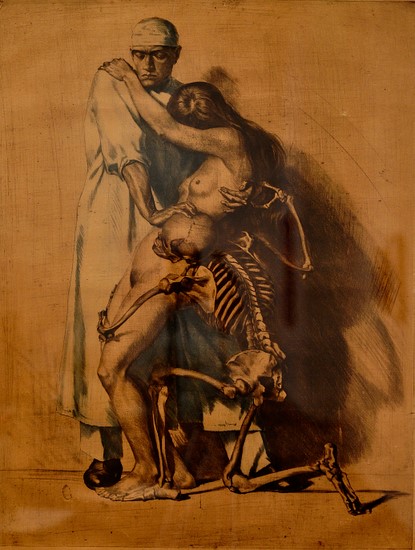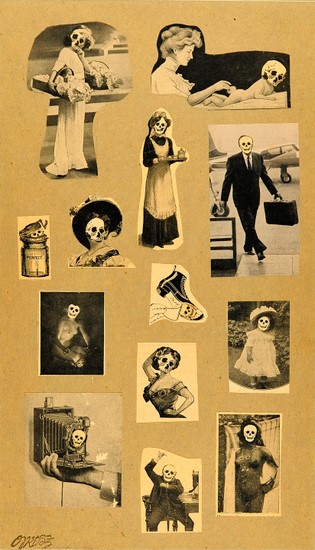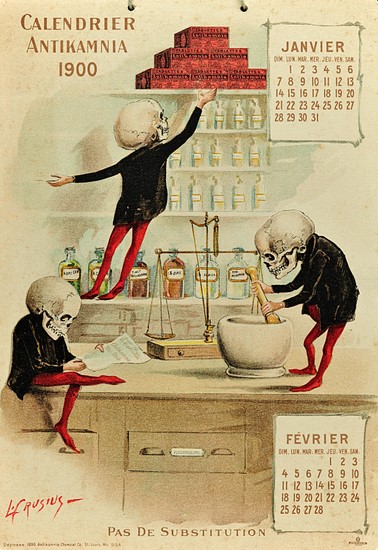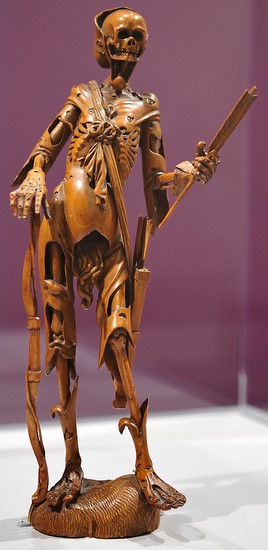One might expect a collection of images featuring the personification of death to be morose, dark, depressing, and grotesque, but in the new Figge Art Museum exhibit Dancing Towards Death, many of the works are instead humorous or thoughtful. The show is more about the uses of death-related imagery (and Death as a character) than death itself, with the skeletal manifestation conjuring a variety of moods and themes.
The show (which runs through January 9) was mostly drawn from a private collection and was supplemented with work from the Figge's collection. The art-history connoisseur will appreciate the inclusion of big names such as Albrecht D?rer, Rembrandt, and Käthe Kollwitz, but the exhibit also features unknown craftspeople, such as the artisans who created Books of Hours. And the accessibility of both the theme and the imagery will provide a meaningful experience for the casual art viewer.
In curating Dancing Towards Death, the Figge successfully shows myriad uses of the skeletal motif over five centuries, but it's Europe-heavy, and works from more cultures might have offered a richer experience. There's nothing here from Asian, Native American, Middle Eastern, or African cultures, and there's only a single reference to Mexican Day of the Dead celebrations - in Victor Delhez's 1948 work Danse Macabre.
Some works primarily serve as a memento mori - a reminder that death will come for us all some day - including an untitled portrait with a skull by Barthel Bruyn the Elder, Faces of Death by Georg Grosz, and Vom Tode, Erster Teil, Opus XI by Max Klinger.
The latter, a portfolio of 10 etchings from 1889, is done with a gorgeous complexity. The series begins with a self-portrait of the artist staring at the horizon, appearing darkly contemplative. The subsequent prints appear to be visualizations of his thoughts on mortality, with death craftily disguising itself to surprise its victims, and the newly departed representing all aspects of society - an artist, a man on a throne, and a lonesome traveler, for instance. The scenes depict beautiful but remote landscapes and realistically rendered figures with flowing, draped clothing, reminiscent of classical narrative painting. At the end of the series, a man kneels before death, calmly accepting his fate. Klinger masterfully integrates a whole spectrum of emotions one could feel toward death before finally reaching calm acquiescence.
The 1958 collage Faces of Death, meanwhile, approaches the topic more playfully. Grosz affixed images (mostly from advertising) of people and consumer goods to a tan background, and then glued an illustration of a skull onto faces as well as inanimate objects. The meaning here is ambiguous, with inevitable mortality balanced tonally by cartoonish skulls and kitschy marketing, with the effect of reminding viewers of death without distressing them by being too realistic.
While Grosz appeared to want to spur ambivalent reactions, a series of calendars produced by Louis Crucius in 1899 uses a similar approach but seems (in retrospect) bizarrely misguided. These illustrations were commissioned by Antikamnia Chemical Company to promote a new line of medicines. The calendars depict people from various professions in seemingly normal environments, except their heads have been replaced by skulls. It appears that Crucius wanted to show death as laughable in the face of this new medication, and the flippant use of death iconography appears often in media as we try to rob the figure of its mystique and power. The irony here is revealed in context provided by the Figge: The advertised medicine was later found to be toxic and addictive.
Other portrayals seem fascinated by the skeleton. The visage of Death appears more seductive in a fruitwood carving made by an unknown artist in 17th Century Germany. The figure's flesh and clothing are formed to appear partially rotted away, revealing the skeleton. Its unnaturally tall and slender body stands in a relaxed pose, leaning on its bow and carrying a quiver of arrows. Despite its grotesque appearance, the wood's smooth, shiny texture is exquisite. The detail of the clothing, bones, and flesh draws the viewer in to inspect the figure closely. The bow and arrow are not threatening, and the skeletal face appears to grin - creating a character who feels more like a guide or protector.
In that way, the carving fits comfortably in a tradition showing Death as a jovial character. The Danse Macabre - usually showing a skeleton leading an individual toward oblivion - began in the 15th Century and often showed Death dancing with his victims. In the Figge exhibit, we see this merry but ominous skeleton appear in the works Death Room/The Last Rites from a Book of Hours circa 1480, as well as in Imago Mortis from the Liber Cronicarum (Nurenberg Chronicles), from 1493. Manuscripts such as these were usually Christian and thus had reason to depict dying as a welcome transition from the toils of life to the eternal pleasure of heaven.
But Dancing Towards Death doesn't skimp on fear and terror. In Kollwitz's 1910 etching Death & a Woman, a female figure is being dragged by a skeleton while a small child reaches toward her, attempting to hold her from death or perhaps accompany her. The background contains nothing but splotches and scratches of ink, leaving no sense of setting. The woman and child seem both powerful and powerless - vulnerable through their poses, clearly losing their physical struggle with death, yet powerful through the force of their resistance and Kollwitz's rendering of dense musculature. This specifically references the torment of losing a parent, and how the passing of one person causes ripples of grief, frustration, and helplessness through families. Death here is a formidable, villainous opponent, but this implies that if we were smart enough or strong enough, we could win. That potential victory is the theme of Ivo Salinger's 1920 piece Der Artz (The Physician), which shows the heroic doctor protecting a woman from Death by placing his hand on its skull.
The exhibit's contextual information - on the walls, near individual works, and on the Figge's Web site - is excellent, leading the viewer to a fulfilling intellectual as well as aesthetic experience. The small descriptions next to the older works are especially informative, but the modern works have not been given the same in-depth treatment. Many newer pieces are simply labeled with the artist, title, and year when additional context would have been illuminating.
But that doesn't detract much from a show that turns the difficult and overwhelming concept of death into a character study. We can dance with it, fight with it, or laugh at it, and through these things, we feel that we can know the unknowable.
Michelle Garrison is a mixed-media artist who teaches art and design at Geneseo Middle School and J.D. Darnell High School. She can be reached at michelle_m_garrison@hotmail.com.














